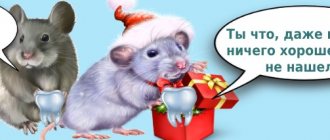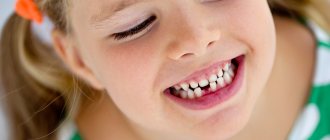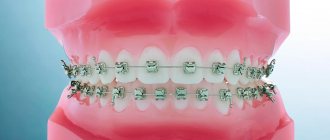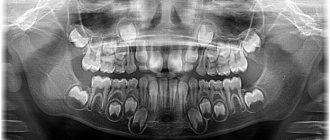How to pull out a baby tooth with floss
The essence of the method is that a loose tooth is tied with a thread, the other end of which is tied to the door handle.
The door opens and the tooth flies out of the mouth. This technique does not withstand any criticism either from dentists or from psychologists. A morally outdated method that can frighten a child and even cause psychological trauma.
Home manipulations often lead to infection in the socket. Inflammation may develop - flux, pain and fever will appear. The best solution is to have loose baby teeth removed at a dental clinic. It's fast, painless and inexpensive.
Why are baby teeth preserved?
The process of preserving baby teeth in the oral cavity is individual. Typically, “baby” teeth live for 2-3 years; over time, their roots dissolve. Having lost their support, baby teeth fall out, allowing permanent teeth to take their place.
In some cases, this process works differently. The formation of molar rudiments may be delayed or may not begin at all. And the baby tooth remains in place for many years. There are several reasons for the absence of the rudiments of replacement teeth:
- hereditary predisposition;
- malfunctions of the endocrine glands;
- metabolic disorders in the patient;
- trauma or osteomyelitis;
- acute or inflammatory diseases;
- the location of the rudiments is too deep.
Due to these phenomena, the development of permanent teeth is delayed or does not occur at all.
Life cycle of teeth
Almost all the organs of our body are formed in the womb. Teeth are no exception. Already at the age of 6 weeks, the rudiments of the first teeth appear in the fetus: 10 pieces each. on the upper and lower jaw. Total - 20 small “buds”. This is the future milk bite.
See an interesting infographic about what kind of life our teeth live, and immediately after - in more detail about each stage and useful tips on how to preserve your teeth until old age.
Life cycle of teeth
| Birth | A child is born with fully formed tooth buds - they are located just under the surface of the gums. It is also interesting that some babies are already born with one or more teeth |
| 2-3 months | The baby begins to cut his first teeth. This is a rather unpleasant process, which is accompanied by excessive salivation, pain, deterioration of the child’s mood, and refusal to eat. In addition, during teething, local immunity is significantly reduced, which increases the risk of developing a viral infection. This explains the frequent increase in temperature during this period. |
| 6-14 months | Teeth begin to appear. The lower incisors grow first, then the upper ones. In total, the child should grow 20 pieces, including 2 multi-root chewing ones on each side - this will be the milk bite |
| 6-7 years | At this time, “baby” teeth begin to fall out. There is a change from a milk bite to a permanent one |
| 12-13 years old | The period of complete completion of the formation of a permanent dentition. By this age, the milky ones should fall out completely, and permanent ones should grow in their place. Helping teeth fall out in most situations is not required - this is a natural and physiological process that does not require third-party intervention. But it’s still worth seeing a doctor: it’s important to monitor both the wound and the process as a whole |
| 17-21 years old | During this period, “wisdom teeth” – the furthest ones in the row – may grow. There are 4 of them in total. There were no dairy predecessors in their place, so they have to pave the way on their own. In addition, they grow at a time when the bone tissue is fully formed and very hard. That is why their growth is associated with such problems as pain, acute inflammation of the mucous membrane, incorrect position in the row and even retention (the tooth does not erupt, forms and remains completely in the bone tissue) |
| 20 years and older | Starting at this age (and if there are problems with the body or when playing dangerous sports, even earlier), we begin to lose teeth. In the absence or poor hygiene, with poor nutrition, and the appearance of diseases of many organs and systems of the body, the enamel becomes weaker and is subject to attack by bacteria. With age, the amount of saliva decreases - and it is this that is a natural means of cleansing plaque. This is largely why teeth and gums become more susceptible to decay. It is also worth remembering that not only dental diseases, but also problems with gums lead to loss. |
Delete or leave?
Milk teeth have reduced resistance to the development of caries and other diseases. These teeth are not designed to last. They can interfere with neighboring teeth and visually look different from molars, which disrupts the aesthetics of the smile.
If you find a baby tooth, contact your dentist. The doctor will assess the condition of the tissue and location, degree of destruction and the need for removal. If there are no indications for removal, the dentist will not prescribe this procedure.
Baby teeth are left if:
- the tooth is well preserved and does not interfere with the rest;
- The molar tooth germ is missing, but the roots of the temporary tooth remain intact.
To determine this, the patient needs to undergo an X-ray diagnosis or undergo a 3D tomography. The image will show whether there are prerequisites for the eruption of a permanent tooth, and what is the condition of the milk root.
When does teeth change?
In order to monitor the order of changing teeth and be able to identify pathology if necessary, you should remember the time frame:
- Children's incisors change at the age of 6-8 years.
- Fangs fall out and new ones appear at 9-12 years of age.
- Molars begin to change at 9-10, and can change up to 12 years.
- Large molars erupt from the age of 6 to 11-13 years, and the last ones (“eights”, so-called “wisdom teeth”) can appear at 20-30 years.
And if you notice a change in incisors and fangs immediately - the child is happy to show everyone his charming toothless smile, then with molars everything is not so simple.
How to distinguish a permanent molar from a baby tooth
You can distinguish between temporary and permanent teeth, first of all, by color. Milk enamel is white and even has a bluish tint.
These are the teeth that are called snow-white. But the permanent ones are always a little darker and have more of a yellowish or grayish tint.
Also, temporary teeth are smaller, and permanent teeth
are larger
; molars and premolars have a large chewing surface and several large tubercles on it. The teeth give the impression of being impressive and strong.
The formula of the dentition in children whose teeth have already been replaced will be similar to that of an adult - 8 incisors, 4 canines, 8 premolars and 8 molars. That is, on one side of the jaw there will be 2 small molars and 2 large molars. To understand this formula and learn to distinguish a permanent molar from a baby tooth, we recommend comparing them in the photo.
How to keep your smile?
If there are no molar rudiments in the image and there are indications for removal, the specialists at Family Dentistry will offer to use the prosthetic service.
If the patient is not satisfied with the baby tooth, the doctor can cover it with a veneer or lumineer. It is also possible to perform tooth restoration.
If there are rudiments of a molar tooth, the dentist estimates how long it will take for eruption to occur. For the baby tooth, extraction is prescribed, and the permanent one is helped to erupt faster.
“Baby” teeth in adulthood are not normal. If the tooth is healthy and not causing problems, it can last for many more years. But, natural molars are much better in functionality and aesthetics than baby teeth or dentures restored by a dentist.
Is it worth treating baby teeth under anesthesia (sedation)
Despite the fact that many parents consider baby teeth to be fake (or, on the contrary, by nature more protected) and underestimate the problems that arise with them, it is still painful to treat baby teeth - just like molars. Therefore, it is important to contact pediatric dentistry, since the requirements for anesthetics for children are more stringent, and the necessary drugs may not be available in a regular “adult” clinic.
In many cases, treating baby teeth under anesthesia is not only possible, but also necessary. A distinction must be made between anesthesia and sedation. Sedation is the process of calming a small patient, relieving excessive agitation or fear before dental procedures. It is achieved with mild, safe means (for example, nitrous oxide) and is not accompanied by pain relief.
Anesthesia involves the patient falling asleep and dental treatment in his sleep. For children, the use of two drugs is allowed: sevoran, administered through a special mask, and propofol, administered intravenously. These are safe, well-tested products that are highly effective and do not affect the child’s nervous system.
Anesthesia is used in cases where it is difficult for the doctor to establish contact with the child, or there is a pathological fear of dental procedures. And also when a voluminous or complex intervention is expected: removal of several teeth, treatment of deep caries or pulpitis, etc. It is very difficult for a preschool child (or primary school student) to sit motionless in a chair for more than 20-30 minutes, and anesthesia will allow him to receive the necessary treatment in full, completely unnoticeably and painlessly.
At what age do children lose their first teeth?
According to statistics, the first baby tooth leaves the socket when the child turns 5-6 years old. The process of changing teeth occurs gradually (otherwise babies would not be able to chew).
Various factors influence the age at which a baby’s first molars appear:
- health of baby teeth;
- fetal development during pregnancy (the rudiments of teeth appear in the womb);
- characteristics of the baby’s body.
How to behave if your child’s first tooth falls out?
The first baby tooth that falls out is another step towards growing up. So why not mark this event with some interesting ritual for the child, so that further loss will be easier for the baby and bring more joy.
Tooth Fairy
Give your baby a little magic. Let the good sorceress take the first tooth from under the pillow while he sleeps, and in return leave a small gift: candy, a coin or a toy. The next baby tooth that falls out will bring joy to the baby.
Mouse
Another tradition that children really like is to give a lost tooth to a mouse. The mouse will chew the old tooth, and a new one will appear in its place.
Together with your baby, you need to find a secluded corner in the house and put the fallen tooth there. At night, a mouse will run into the corner and take it away.
We hope that falling out baby teeth and emerging permanent teeth will not cause trouble for either children or parents. And to make the first molars give the baby even more joy, we have developed a special Asepta Teens toothpaste to protect and strengthen the enamel of permanent teeth in children over 8 years old. The paste increases the resistance of enamel to bacteria and acids, helps saturate teeth with calcium and phosphorus, and provides effective protection against caries and gum inflammation. And the rich taste of apricot, peach and cream will turn brushing your teeth into a real treat.
Molars fall out
If molars suddenly begin to fall out suddenly, this is a sign that the child’s health is not in the best condition. Tooth loss is preceded by both systemic diseases (immune problems, impaired development of connective tissue) and local ones (caries, pulpitis, periodontal disease, etc.). Tooth from permanent dentition. When lost, it leaves behind a permanent problem. A radical solution could be a complete insertion of an artificial tooth - but... Before it is carried out, the child will have to use a removable and replaceable prosthesis before he grows up.
How to determine that a child will soon have molars?
According to some of the signs, interdental intervals initially increase. This happens due to the growth of the jaw bones - the teeth begin to not fit tightly together, as happens in adults. Then the temporary teeth gradually become loose - due to the gradual disappearance of the temporary root, which can no longer reliably hold such a tooth, and itself is gradually pushed out of the soft and semi-soft tissues on the jaw. The loss of a temporary tooth is a clear sign that the permanent tooth is already growing in full force, and the top of its crown will soon push apart the gum tissue. The appearance of a new tooth is also accompanied by slight redness and swelling. If a child or teenager has a fever, their health has worsened, and their gums hurt, go to the doctor immediately.











